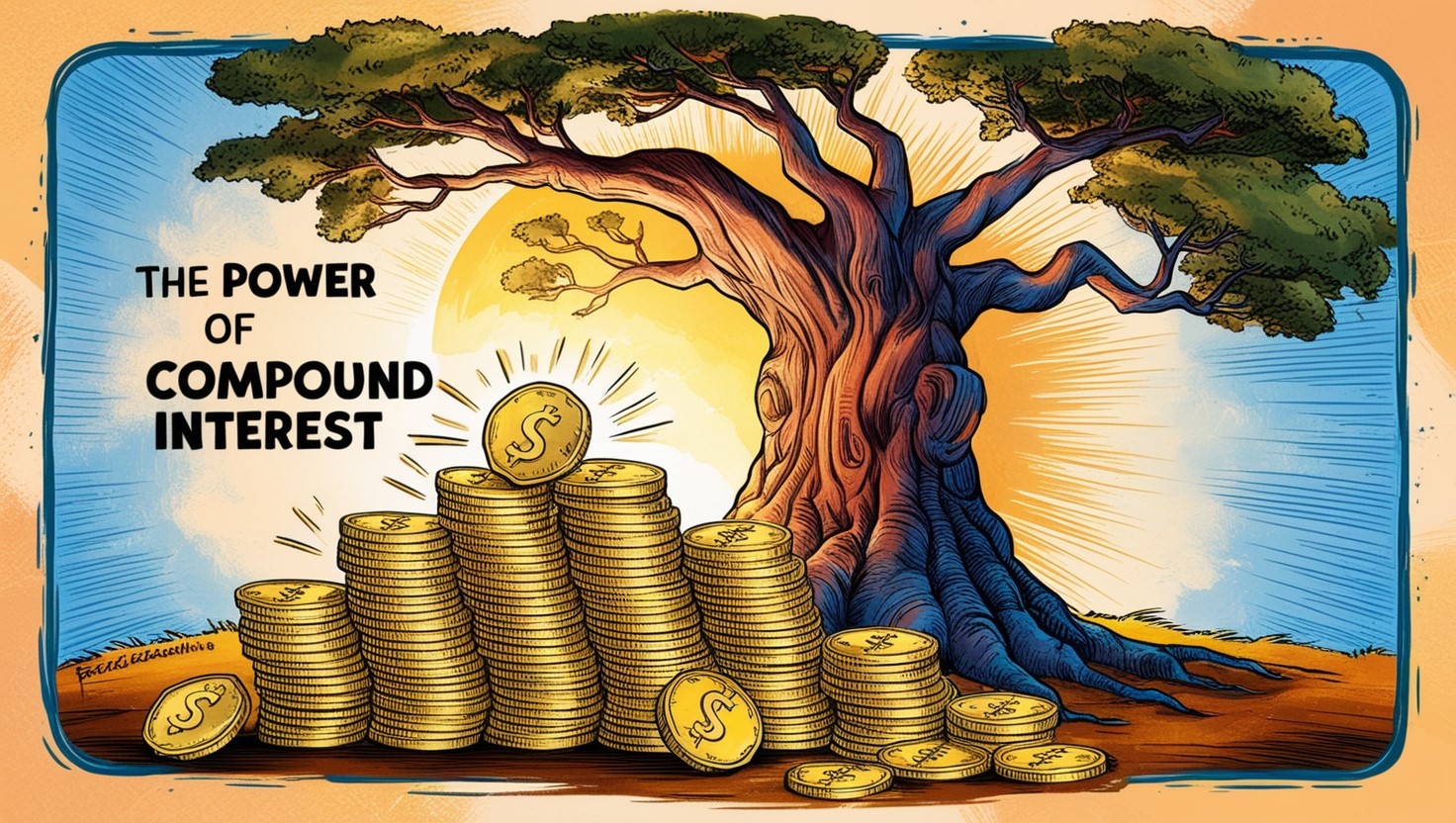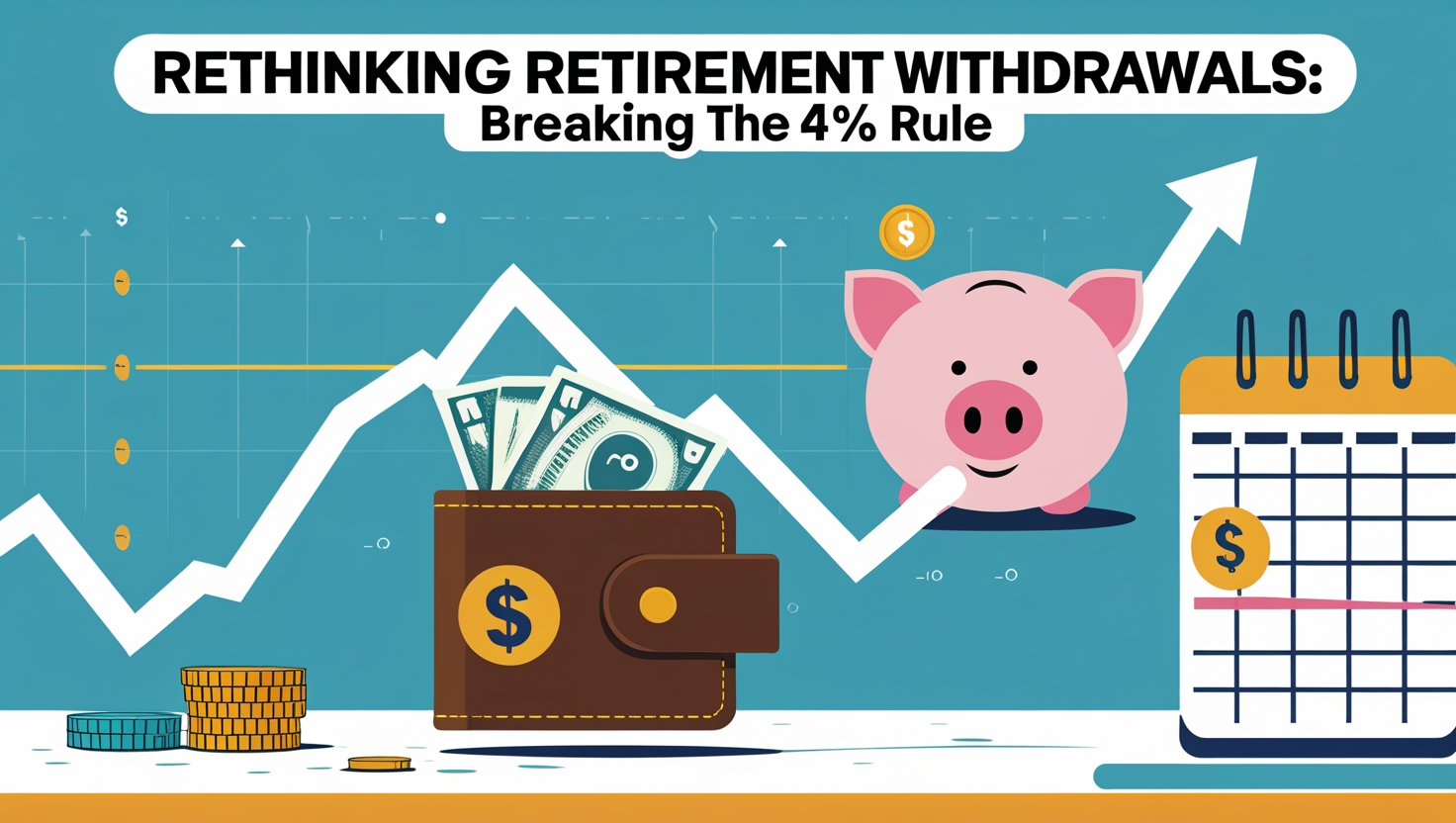When it comes to the world of finance, there’s a saying that often sparks curiosity: “Compound interest is the 8th wonder of the world.” But what exactly does that mean? At its core, compound interest is the magical force that transforms the money you invest into something far greater over time. It’s not just about earning interest on your initial investment; it’s about earning interest on the interest itself, creating a powerful snowball effect that can lead to significant wealth accumulation.
Imagine putting your money to work, allowing it to grow silently in the background, compounding year after year. It’s a concept that seems simple but can yield extraordinary results, especially when given enough time. Yet, many people underestimate its potential, often focusing solely on immediate gains rather than the long-term benefits of compounding.
In this guide, we’ll delve into the fascinating world of compound interest, breaking down its mechanics and uncovering why it deserves the title of the 8th wonder. From understanding how it works to exploring practical strategies for harnessing its power, you’ll discover how compound interest can be your most powerful ally in achieving financial success. So, let’s embark on this enlightening journey together and unlock the secrets of making your money work for you!
Understanding Compound Interest
To truly appreciate the power of compound interest, it’s essential to grasp what it is and how it works. At its core, compound interest is the process where the interest earned on an investment is reinvested, allowing you to earn interest on both the initial principal and the accumulated interest over time. This cycle of growth is what makes compound interest so extraordinary—and often referred to as the 8th wonder of the world.
Let’s break it down. When you invest money, whether in a savings account, a bond, or a stock, you earn interest on that initial amount. With compound interest, rather than simply taking that interest as cash, you reinvest it, allowing your investment to grow exponentially. This means that in the next period, your interest is calculated not just on your original investment, but also on the interest that has already been added. It’s a cycle that continues, creating a snowball effect that can lead to significant growth over time.
To illustrate this, consider the classic example of two friends: Alice and Bob. Alice starts investing $1,000 at an annual interest rate of 5%, and she leaves it untouched for 30 years. Meanwhile, Bob waits 10 years before investing the same amount at the same interest rate for 20 years. At the end of 30 years, Alice’s investment will have grown significantly due to the power of compounding, while Bob’s investment, though made later, won’t catch up to hers. This example highlights the critical importance of time in harnessing the benefits of compound interest. The earlier you start, the more time your money has to grow.
Moreover, the effects of compound interest are not linear; they are exponential. This means that as time goes on, the amount of interest earned grows faster and faster, thanks to the interest being added to the principal. This phenomenon is why people often emphasize the importance of starting your investment journey as soon as possible, even if you can only contribute a small amount at first.
In summary, understanding compound interest is key to unlocking your financial potential. By recognizing how it works and leveraging its power, you can set yourself on a path to greater wealth and financial security. As we continue, we’ll delve into the mechanics of how to calculate compound interest, its benefits, and practical applications in everyday financial planning. Get ready to discover just how transformative this financial principle can be!
The Mechanics of Compound Interest
Understanding the mechanics of compound interest is crucial for anyone looking to make the most of their investments. While the concept might seem straightforward, the details can make a significant difference in how your money grows over time. Let’s break it down.
1. The Formula
At its core, the formula for calculating compound interest is both simple and powerful:

Where:
- A is the amount of money accumulated after n years, including interest.
- P is the principal amount (the initial investment).
- r is the annual interest rate (decimal).
- n is the number of times that interest is compounded per year.
- t is the number of years the money is invested or borrowed.
This formula shows how each component interacts with the others to determine the final amount. For instance, the more frequently the interest is compounded, the more you earn.
2. Compounding Frequency
The frequency at which interest is compounded can dramatically affect your investment’s growth. Here’s a quick overview of common compounding intervals:
- Annually: Interest is added once a year.
- Semi-Annually: Interest is added twice a year.
- Quarterly: Interest is added four times a year.
- Monthly: Interest is added twelve times a year.
- Daily: Interest is added every day.
The more often interest is compounded, the more interest you will earn on the accumulated interest. For example, an investment that compounds daily will grow faster than one that compounds annually, even if the interest rate is the same.
3. The Time Factor
Time plays a pivotal role in the mechanics of compound interest. The longer your money remains invested, the more it benefits from compounding. This is why starting early can make a significant difference in your financial journey. Even small contributions can grow into substantial sums over time thanks to the power of compounding.
4. Principal and Interest
Understanding the relationship between the principal and the interest earned is vital. As your investment grows, a larger portion of your returns will come from the interest rather than the principal. This shift is what makes compound interest so powerful; the longer your money is invested, the more the interest starts to take the lead in your overall earnings.
5. Visualizing Growth
To truly appreciate compound interest, it can be helpful to visualize its effects. Many online calculators can illustrate how your money might grow over time with different initial investments, interest rates, and compounding frequencies. These visual aids can show the exponential growth curve that compound interest creates, emphasizing how small changes can lead to significant differences in your financial future.
In summary, the mechanics of compound interest involve understanding the formula, the impact of compounding frequency, and the importance of time. By grasping these concepts, you can take control of your investments and make informed decisions that align with your financial goals. As we move forward, we’ll explore the numerous benefits of compound interest and how it can help you build wealth effectively.
Factors Affecting Compound Interest
When it comes to harnessing the true power of compound interest, several key factors come into play. Understanding these variables can help you maximize your investment growth and make informed financial decisions. Let’s dive into the most influential factors that affect compound interest:
1. Interest Rate
The interest rate is perhaps the most critical factor influencing how quickly your money grows. A higher interest rate means that you earn more on your investment, resulting in a larger accumulation of wealth over time. For instance, investing $1,000 at a 5% interest rate will yield significantly less than the same amount invested at 10%. This underscores the importance of shopping around for the best rates, whether you’re looking at savings accounts, bonds, or investment opportunities.
2. Time
Time is the silent partner in the equation of compound interest. The longer you allow your money to grow, the more pronounced the effects of compounding become. Even small contributions can lead to substantial gains if given enough time to compound. For example, if you start investing early in life, even modest investments can blossom into impressive sums due to the compounding effect working over decades. This is often why financial advisors stress the importance of starting early—time is your greatest ally in wealth accumulation.
3. Compounding Frequency
As discussed earlier, the frequency with which interest is compounded can significantly impact your returns. Interest can be compounded annually, semi-annually, quarterly, monthly, or even daily. The more frequently interest is added to your principal, the more interest you earn on your interest, accelerating your investment growth. If you have a choice, opting for investments that compound more frequently can lead to greater wealth over time.
4. Initial Principal
The amount of money you start with—your principal—also plays a crucial role in how much compound interest you can earn. A larger initial investment provides a more substantial base for your interest calculations. If you invest $5,000 instead of $1,000, the impact of compounding will be significantly more pronounced. Thus, saving as much as you can initially will help set a strong foundation for your financial future.
5. Additional Contributions
Making regular contributions to your investment can amplify the benefits of compound interest. By adding money to your investment consistently—whether monthly, quarterly, or annually—you increase the principal amount on which interest is calculated. This strategy not only enhances the compounding effect but also encourages disciplined saving habits. Even small, regular contributions can add up over time, significantly boosting your total returns.
6. Inflation
While compound interest works wonders for growing your money, it’s essential to consider the impact of inflation. Inflation erodes purchasing power, which means that the value of your returns may not stretch as far as you’d like. It’s important to factor in inflation when planning your investment strategy to ensure your returns outpace it. Investing in assets that typically yield higher returns than inflation can help you preserve and grow your wealth effectively.
In summary, several factors influence the power of compound interest, including interest rates, time, compounding frequency, initial principal, additional contributions, and inflation. By understanding and optimizing these elements, you can leverage the incredible potential of compound interest to build a solid financial future. As we continue, we’ll explore the numerous benefits of compound interest and how it can be a game-changer in your journey to wealth accumulation.
Practical Applications of Compound Interest
Understanding compound interest is one thing, but applying it effectively in your financial life is where the real magic happens. By leveraging this powerful concept, you can make informed decisions that will significantly impact your savings and investments. Here are some practical applications of compound interest that can help you grow your wealth over time:
1. Savings Accounts
One of the simplest ways to harness the power of compound interest is through a high-yield savings account. These accounts allow your money to grow with interest that compounds regularly. While traditional savings accounts may offer minimal interest, high-yield options provide a much better return. By depositing your savings into a high-yield account, you can watch your money grow passively over time, making it an ideal place for your emergency fund or short-term savings goals.
2. Retirement Accounts
Investing in retirement accounts like a 401(k) or an IRA is one of the most effective ways to take advantage of compound interest. These accounts not only offer tax benefits but also allow your investments to grow without immediate tax implications. The earlier you start contributing to these accounts, the more time your money has to compound. Regular contributions, combined with employer matching (if available), can significantly boost your retirement savings and ensure a comfortable financial future.
3. Investment in Stocks and Mutual Funds
Compound interest isn’t limited to savings accounts; it also applies to investments in stocks, bonds, and mutual funds. By reinvesting dividends and interest earned, you can accelerate the compounding process. Many investors choose to automatically reinvest dividends through their brokerage accounts, allowing their investments to grow more rapidly over time. The stock market may have its ups and downs, but historically, long-term investments tend to yield positive returns, benefiting greatly from the power of compounding.
4. Education Savings Accounts
For those planning for a child’s education, accounts like a 529 plan can be a smart choice. These accounts allow parents to save for future education expenses while benefiting from compound interest. Contributions grow tax-free, and if used for qualified education expenses, withdrawals are also tax-free. Starting early and making regular contributions can result in significant savings by the time your child is ready for college.
5. Debt Repayment
While most discussions about compound interest focus on growth, it’s equally important to understand its impact on debt. High-interest debt, such as credit cards, can quickly accumulate if left unpaid, leading to an ever-increasing balance. By prioritizing debt repayment and understanding how interest compounds on outstanding balances, you can take proactive steps to minimize costs. Strategies like the snowball or avalanche methods can help you pay off debt more efficiently and save money on interest in the long run.
6. Real Estate Investment
Real estate can also benefit from the power of compound interest, especially when leveraged appropriately. If you invest in rental properties, the income generated can be reinvested, allowing you to purchase additional properties or make improvements that increase the property’s value. Over time, the appreciation in property value, combined with rental income, can lead to substantial wealth accumulation through the principles of compounding.
7. Budgeting and Financial Planning
Incorporating the concept of compound interest into your budgeting and financial planning can change the way you approach savings and investments. By setting clear savings goals and understanding how your contributions can grow over time, you can create a more focused financial strategy. Whether saving for a home, a vacation, or retirement, knowing the potential growth of your savings can motivate you to stick to your plan.
In summary, the practical applications of compound interest are vast and varied. Whether you’re saving for a rainy day, planning for retirement, or investing in your child’s education, understanding and applying compound interest can lead to significant financial benefits. By taking advantage of this powerful concept, you can set yourself on a path to financial security and success. As we move forward, we’ll explore some common misconceptions about compound interest and how to navigate them effectively.
Common Misconceptions About Compound Interest
As with any financial concept, compound interest is often shrouded in myths and misunderstandings. These misconceptions can lead to missed opportunities for wealth accumulation and smart financial planning. Let’s clear the air by addressing some of the most common misconceptions surrounding compound interest.
1. Compound Interest Only Benefits Large Investments
One prevalent myth is that only large investments benefit from compound interest. In reality, compound interest works wonders on even small amounts of money. The key is to start early and let time do its magic. Even modest contributions, when invested wisely, can grow significantly over time due to compounding. It’s about making the most of your time in the market rather than the size of your initial investment.
2. The Effect of Compounding is Immediate
Another misconception is that the effects of compound interest are felt immediately. Many people expect to see significant growth right after they invest. In truth, compounding takes time. The most substantial growth typically occurs in the later years of an investment. This is why patience is crucial—allowing your investment to grow over time is what leads to the exponential benefits of compounding.
3. All Interest Earned is Compound Interest
Some may think that all interest earned is compound interest, but that’s not the case. Compound interest specifically refers to the interest calculated on both the initial principal and the accumulated interest from previous periods. In contrast, simple interest is calculated solely on the principal. Understanding this distinction is essential for maximizing your investment growth.
4. Compound Interest Only Applies to Savings Accounts
Many people believe that compound interest is only relevant to savings accounts, but it extends to various investment vehicles. Stocks, bonds, mutual funds, and even real estate can benefit from the compounding effect. When dividends are reinvested or rental income is reinvested, the principles of compound interest apply, amplifying potential returns.
5. Higher Interest Rates Always Mean Better Returns
While it’s true that higher interest rates can lead to better returns, this statement oversimplifies the situation. Other factors, such as compounding frequency and investment time horizon, also play crucial roles in overall growth. It’s essential to consider the whole picture rather than solely focusing on the interest rate.
6. You Can’t Lose Money with Compound Interest
There’s a dangerous belief that investing with compound interest is foolproof and guarantees gains. Unfortunately, this isn’t true. While compounding can lead to significant growth, investments come with risks. Market fluctuations can impact the value of investments, and there’s no guarantee of returns. It’s vital to understand the risks involved and make informed decisions.
7. Compound Interest is Only for the Wealthy
Many believe that only wealthy individuals can take advantage of compound interest. In reality, anyone can benefit from compounding, regardless of their financial status. The important thing is to start saving and investing early, even with small amounts. Building a habit of saving and allowing those funds to grow over time can create a pathway to financial stability and wealth.
8. Understanding Compound Interest is Too Complicated
Lastly, some people feel overwhelmed by the concept of compound interest, thinking it’s too complicated to grasp. However, the principles are quite straightforward, and with a little effort, anyone can learn how it works. Numerous resources, including calculators and educational materials, can help demystify compound interest and empower individuals to take charge of their financial futures.
In conclusion, debunking these common misconceptions about compound interest is crucial for making informed financial decisions. By understanding the true nature of compound interest, you can unlock its potential to grow your wealth and secure your financial future. As we continue, we’ll explore effective strategies for maximizing the benefits of compound interest in your investment journey.
Strategies for Maximizing Compound Interest
Now that we’ve explored the power of compound interest and dispelled some common misconceptions, it’s time to dive into actionable strategies that can help you maximize its benefits. By applying these strategies, you can make the most of your investments and set yourself on a path to financial success.
1. Start Early
The single most effective strategy for harnessing the power of compound interest is to start investing as early as possible. Time is your greatest ally when it comes to compounding. The sooner you begin, the more time your money has to grow. Even small contributions made early can turn into significant amounts over the years. If you’re in your 20s, you have the incredible advantage of decades of compounding ahead of you—so don’t wait!
2. Make Regular Contributions
Consistency is key. Establishing a habit of making regular contributions to your investments can dramatically enhance the effects of compounding. Consider setting up automatic transfers to your savings or investment accounts each month. By treating these contributions like a bill you must pay, you prioritize your financial growth and create a discipline that pays off in the long run.
3. Reinvest Earnings
Whenever you earn interest, dividends, or capital gains, consider reinvesting them rather than cashing them out. Reinvesting allows you to take full advantage of compound interest, as you will earn returns on your reinvested earnings. This strategy can significantly accelerate the growth of your investments, making your money work even harder for you.
4. Take Advantage of Tax-Advantaged Accounts
Utilize tax-advantaged accounts like 401(k)s, IRAs, or Health Savings Accounts (HSAs). These accounts not only provide potential tax benefits but also allow your investments to grow without immediate tax implications. By maximizing contributions to these accounts, you can increase your overall returns and take advantage of compounding without the tax burden.
5. Focus on High-Quality Investments
Investing in assets with a strong potential for growth is crucial for maximizing compound interest. While it’s tempting to chase high returns, it’s important to do your research and select high-quality investments that align with your risk tolerance and financial goals. Stocks, index funds, and mutual funds that have historically shown strong performance can be excellent vehicles for capitalizing on compound interest.
6. Monitor and Adjust Your Portfolio
Regularly reviewing your investments allows you to make informed decisions about your portfolio. As market conditions change, you might need to adjust your asset allocation or rebalance your portfolio to ensure you’re on track to meet your financial goals. Keeping an eye on your investments enables you to maximize your potential returns through compounding.
7. Keep an Eye on Fees
Investment fees can eat into your returns and significantly impact the power of compounding. Look for low-cost investment options, such as index funds or exchange-traded funds (ETFs), that have lower expense ratios. By minimizing fees, you allow more of your money to stay invested, enhancing the compounding effect.
8. Be Patient
Finally, patience is a crucial ingredient in the recipe for maximizing compound interest. Financial growth takes time, and it’s essential to resist the urge to react to short-term market fluctuations. By staying focused on your long-term goals and maintaining your investment strategy, you can harness the full potential of compound interest.
In summary, maximizing compound interest requires a proactive approach. By starting early, making regular contributions, reinvesting earnings, and being mindful of fees, you can significantly enhance the growth of your investments. Embrace these strategies, and you’ll be well on your way to enjoying the remarkable benefits of compound interest, ultimately achieving your financial goals. As we conclude, let’s reflect on the transformative power of compound interest and how it can shape your financial future.
Final Thoughts
In the grand tapestry of financial wisdom, compound interest stands out as a remarkable force—often dubbed the 8th wonder of the world. Throughout this exploration, we’ve uncovered the essence of compound interest, from its mechanics and applications to the strategies that can help you harness its power.
The journey toward financial success is not merely about earning money; it’s about making your money work for you over time. By understanding how compound interest operates, you can appreciate the profound impact that time and consistent contributions can have on your wealth. Whether you’re starting with a small investment or looking to grow a sizable portfolio, the principles of compounding are universal and accessible to everyone.
As you reflect on your financial goals, remember the importance of starting early, making regular contributions, and choosing high-quality investments. By employing the strategies discussed, you can cultivate an environment where your wealth can flourish, leading to exponential growth over the years.
Ultimately, the power of compound interest is not just a mathematical concept; it’s a mindset. Embrace the journey of investing, remain patient, and keep your eyes on the long-term horizon. As you do, you’ll find that the magic of compounding can transform your financial future, turning your dreams into reality. Here’s to your journey toward financial empowerment, where every dollar you invest becomes a stepping stone toward your aspirations.



